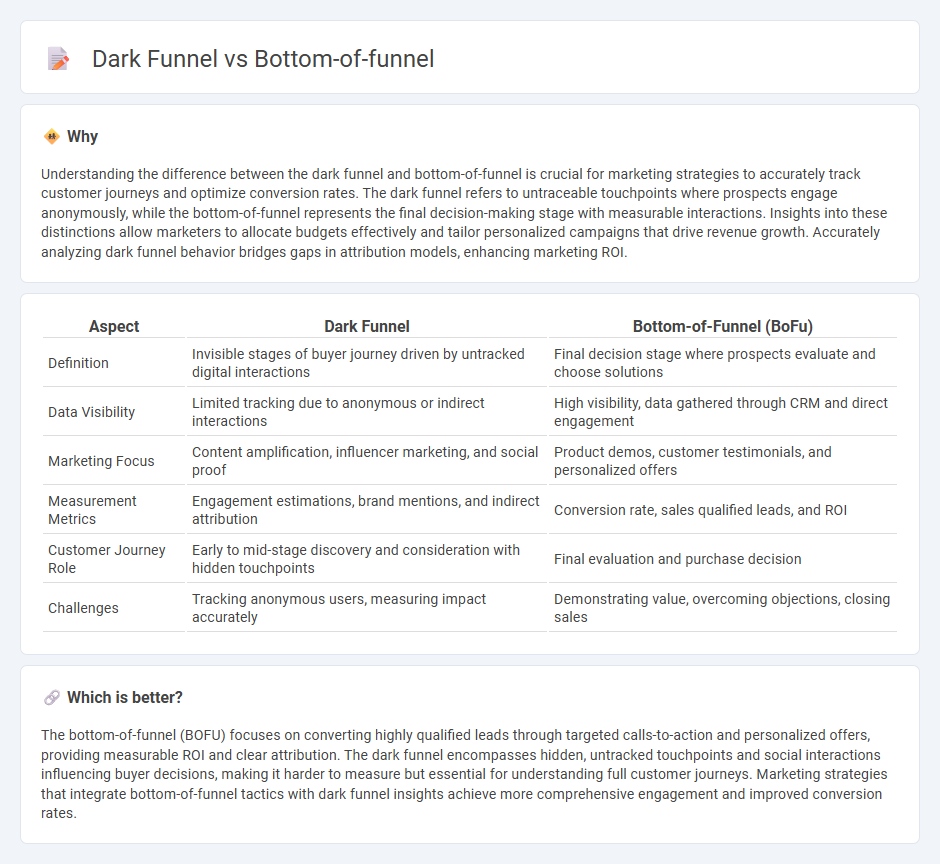
Dark funnel marketing involves tracking the hidden pathways consumers take before making a purchase, focusing on anonymous interactions and untraceable touchpoints. Bottom-of-funnel marketing targets prospects ready to convert, leveraging precise data to maximize conversion rates and finalize sales. Explore deeper insights into optimizing strategies across the dark funnel and bottom-of-funnel stages.
Why it is important
Understanding the difference between the dark funnel and bottom-of-funnel is crucial for marketing strategies to accurately track customer journeys and optimize conversion rates. The dark funnel refers to untraceable touchpoints where prospects engage anonymously, while the bottom-of-funnel represents the final decision-making stage with measurable interactions. Insights into these distinctions allow marketers to allocate budgets effectively and tailor personalized campaigns that drive revenue growth. Accurately analyzing dark funnel behavior bridges gaps in attribution models, enhancing marketing ROI.
Comparison Table
| Aspect | Dark Funnel | Bottom-of-Funnel (BoFu) |
|---|---|---|
| Definition | Invisible stages of buyer journey driven by untracked digital interactions | Final decision stage where prospects evaluate and choose solutions |
| Data Visibility | Limited tracking due to anonymous or indirect interactions | High visibility, data gathered through CRM and direct engagement |
| Marketing Focus | Content amplification, influencer marketing, and social proof | Product demos, customer testimonials, and personalized offers |
| Measurement Metrics | Engagement estimations, brand mentions, and indirect attribution | Conversion rate, sales qualified leads, and ROI |
| Customer Journey Role | Early to mid-stage discovery and consideration with hidden touchpoints | Final evaluation and purchase decision |
| Challenges | Tracking anonymous users, measuring impact accurately | Demonstrating value, overcoming objections, closing sales |
Which is better?
The bottom-of-funnel (BOFU) focuses on converting highly qualified leads through targeted calls-to-action and personalized offers, providing measurable ROI and clear attribution. The dark funnel encompasses hidden, untracked touchpoints and social interactions influencing buyer decisions, making it harder to measure but essential for understanding full customer journeys. Marketing strategies that integrate bottom-of-funnel tactics with dark funnel insights achieve more comprehensive engagement and improved conversion rates.
Connection
The dark funnel encompasses all unseen consumer interactions and touchpoints that occur before reaching the bottom-of-funnel stage, making it a critical source of influence on final purchase decisions. Data-driven marketing strategies analyze dark funnel behavior to optimize bottom-of-funnel targeting and conversion rates. Understanding this connection enables marketers to close attribution gaps and improve ROI by capturing hidden buyer intent throughout the customer journey.
Key Terms
**Bottom-of-funnel:**
Bottom-of-funnel (BOFU) marketing targets prospects at the final stage of the buyer's journey, where they are ready to make a purchase decision. It includes strategies like personalized offers, product demos, and detailed case studies designed to convert leads into customers. Explore more about effective BOFU tactics to maximize your conversion rates.
Conversion
Bottom-of-funnel (BOFU) marketing targets leads ready to convert, emphasizing personalized offers, detailed product information, and strong calls-to-action to drive sales. Dark funnel refers to untrackable, indirect interactions such as word-of-mouth or offline conversations that influence buying decisions without leaving digital footprints. Explore strategic approaches to leverage both BOFU tactics and dark funnel insights for maximizing conversion rates.
Lead Qualification
Bottom-of-funnel lead qualification targets prospects actively engaging with sales content, demonstrating high purchase intent through explicit actions like form submissions and product inquiries. Dark funnel leads remain elusive, often interacting through untracked touchpoints such as offline conversations or anonymous content consumption, requiring advanced data analysis and predictive scoring to uncover true interest. Explore effective strategies to bridge the gap between bottom-of-funnel visibility and dark funnel insights for optimized lead conversion.
Source and External Links
What is Bottom of the Funnel (BOFU)? Examples - Upland Software - The Bottom of the Funnel (BOFU) is the final stage in the marketing funnel where prospects are ready to convert and make a purchase, marking the culmination of their customer journey.
Top Of Funnel, Middle Funnel, and Bottom Of Funnel Explained - Bottom-of-funnel activities focus on converting warm leads into paying customers through tactics like sales outreach and targeted ads, with key metrics including leads generated, qualified leads, and deals closed.
Upper-Funnel vs. Lower-Funnel Marketing: What's the Difference? - Bottom-of-funnel marketing targets prospects who know their problem and are deciding to buy, aiming to close sales by addressing objections and encouraging the final purchase decision.
 dowidth.com
dowidth.com